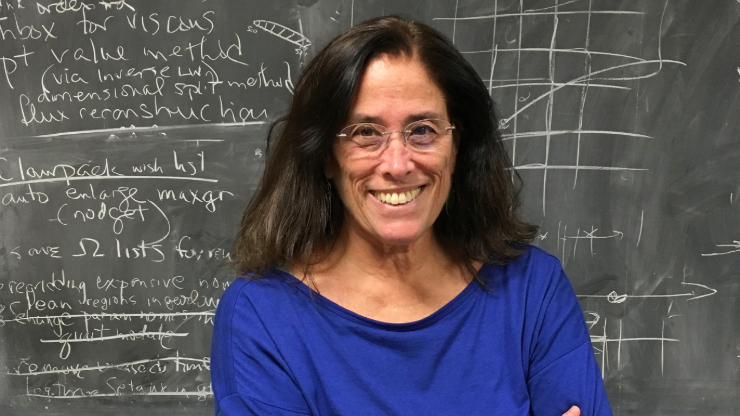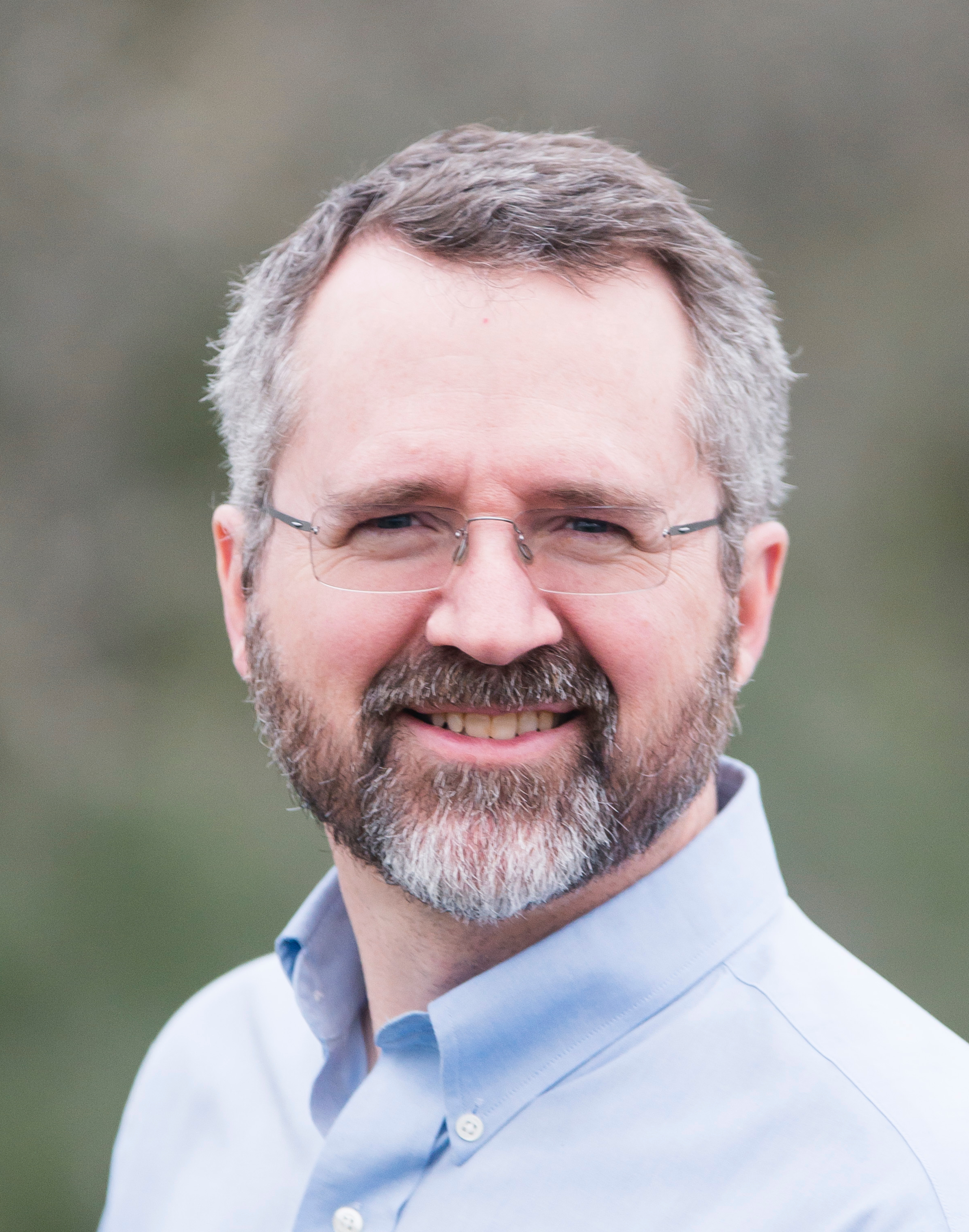2025 July Prize Spotlight
Congratulations to the following 20 SIAM prize recipients who will be recognized at the Third Joint SIAM/CAIMS Annual Meetings (AN25), taking place July 28 – August 1, 2025, in Montréal, Québec, Canada, along with the following co-located conferences: the SIAM Conference on Applied and Computational Discrete Algorithms (ACDA25), happening July 30 – August 1, 2025; the SIAM Conference on Computational Geometric Design (GD25), happening July 28 – 30, 2025; and the SIAM Conference on Control and Its Applications (CT25), happening July 28 – 30, 2025. All awardees will be recognized at the Honors and Awards Luncheon on Tuesday, July 29 at 12:15 p.m. ET.
- Richard Allen – SIAM Industry Prize
- Marsha Berger – John von Neumann Prize Lecture
- Sergio Conti, Stefan Müller, and Michael Ortiz – Jerald L. Ericksen Prize
- Alex Conway – SIAM Activity Group on Applied and Computational Discrete Algorithms Early Career Prize
- Timothy A. Davis – I. E. Block Community Lecture
- Ethan N. Epperly – SIAM Student Paper Prize
- S. Rasoul Etesami – SIAM Activity Group on Control and Systems Theory Best SICON Paper Prize
- Carles Falcó – SIAM Student Paper Prize
- Tamara G. Kolda – SIAM Prize for Distinguished Service to the Profession
- Paul Manns and Annika Schiemann – SIAM Activity Group on Control and Systems Theory Best SICON Paper Prize
- Mason A. Porter – George Pólya Prize for Mathematical Exposition
- Alfio M. Quarteroni – Ralph E. Kleinman Prize
- Oded Stein – SIAM Activity Group on Geometric Design Early Career Prize
- Marius Tucsnak – W. T. and Idalia Reid Prize
- Henk van Waarde – SIAM Activity Group on Control and Systems Theory Prize
- Peter A. Whalley – SIAM Student Paper Prize
- Yongjie Jessica Zhang – AWM-SIAM Sonia Kovalevsky Lecture
Richard Allen
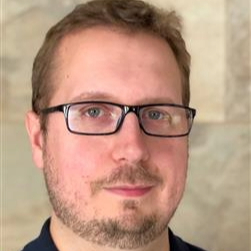
Dr. Richard Allen, Pfizer Inc., is the recipient of the 2025 SIAM Industry Prize. He received the award “for developing numerous QSP models for drug development, particularly for COVID-19. The model and code were shared to help others in both academia and industry. The model was used to predict several key questions, such as the efficacy of the anti-viral treatment when dosed after the peak viral load, the optimal duration of treatment, and the level of benefit to patients.” Dr. Allen will deliver a lecture at AN25 titled “Bringing Medicines to Patients with Mathematical Biology” on Thursday, July 31 at 2:45 p.m. ET.
The SIAM Industry Prize is awarded every year to an individual researcher or team (referred to as “awardee”) who has had outstanding contributions to the effective application of mathematical sciences to industry. This work and its impact may be documented in letters that convey the significance and importance of the work, and/or peer reviewed papers, conference proceedings and/or patents. This will be the first time that the prize will be awarded.
Dr. Allen has been supporting drug discovery and development with mechanistic modeling at Pfizer for the last 13 years. He holds a Ph.D. in applied mathematics from University College London and was subsequently a postdoctoral fellow at the University of North Carolina. His research interests include modeling the dynamics of disease and treatment and developing virtual populations for robust simulation-based predictions.
Q: Why are you excited to receive the award?
A: I am delighted to receive this award as it highlights the beneficial contributions mathematics can make in the understanding and treatment of disease, ultimately assisting in bringing these medicines to patients. I am honored at the personal recognition from peers – it is humbling.
Q: What does your work mean to the public?
A: A particular highlight of working as a mathematician in the pharmaceutical industry is the close connection between helping advance a project and ultimate benefit to patients. This end goal is an ever-present motivator, one that was more evident during the COVID-19 pandemic. Being able to apply mathematical approaches and see how that translates into impacting the developmental path of a medicine is both a privilege and a challenge.
Q: Could you tell us about the research that won you the award?
A: My main area of research is in quantitative systems pharmacology (QSP). In particular, my group develops systems models of disease dynamics – typically ODEs – to test in silico hypotheses or resolve critical biological or physiological uncertainties. An example of this is our development of a COVID-19 model that we rapidly built during the early time-points of the pandemic. We used this model to help answer many questions such as: When can you efficaciously dose an anti-viral? How long do you have to dose for? Should you dose some populations differently?
Q: What does being a member of SIAM mean to you?
A: SIAM is a great community and facilitates my learning from other mathematicians. I really value the conferences that SIAM organizes, where I have never failed to leave impressed, humbled, and inspired by the contributions of SIAM members.
Interested in submitting a nomination for the SIAM Industry Prize? The prize is currently accepting nominations until October 15, 2025.
Sergio Conti, Stefan Müller, and Michael Ortiz
Drs. Sergio Conti, Stefan Müller, and Michael Ortiz are the recipients of the 2025 Jerald L. Ericksen Prize. The team received the award for their paper, "Data Driven Problems in Elasticity," Arch Rational Mech Analysis, Vol. 229, pp. 79-123 (2018), “which influenced a new direction for applied mathematics.” Dr. Conti will deliver a lecture at AN25 titled “Variational Analysis of a Data-Driven Formulation of the Theory of Elasticity” on Wednesday, July 30 at 3:00 p.m. ET.

The Jerald L. Ericksen Prize is awarded every five years for the original formulation of a mathematical theory of a significant scientific or engineering problem in the fifteen years preceding the award date. This will be the first time that the prize will be awarded.
Dr. Conti is an Italian mathematician specializing in mathematical analysis and the calculus of variations, with a focus on applications to elasticity, crystal plasticity, dislocations, and microstructures in materials science. He studied physics at the Scuola Normale Superiore and the University of Pisa (1990-94), earning his Ph.D. in physics from the Scuola Normale Superiore (1997). Previously, Dr. Conti was a postdoctoral associate at the Max Planck Institute for Mathematics in the Sciences in Leipzig (1997-2004), and he completed his habilitation in mathematics at the University of Leipzig (2004). He served as a professor at the University of Duisburg-Essen (2004-08) before joining the University of Bonn, where he has been a professor at the Institute for Applied Mathematics since 2008. Learn more about Professor Conti.
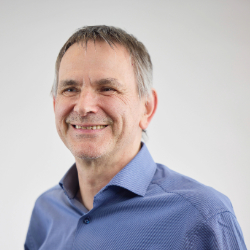
Dr. Müller works in analysis, the calculus of variations, and continuum mechanics, with a focus on microstructures in materials science. He studied mathematics at the University of Bonn and earned his Ph.D. from Heriot-Watt University in Edinburgh (1989) under the supervision of John M. Ball. Following academic positions at Carnegie Mellon University and the University of Bonn, he became a full professor at the University of Freiburg (1994) and at ETH Zürich (1995). The following year, he was appointed founding director of the Max Planck Institute for Mathematics in the Sciences in Leipzig, a position he held until 2008. Since then, Dr. Müller has served as a professor at the University of Bonn and as an external scientific member of the Max Planck Institute for Mathematics in Bonn. Dr. Müller has received numerous awards, including the European Mathematical Society Prize (1992), the Max Planck Research Award (1993), the ICIAM Collatz Prize (1999), and the Gottfried Wilhelm Leibniz Prize (2000). Additionally, he is a member of several academies, such as the Leopoldina and the Berlin-Brandenburg Academy of Sciences and Humanities.
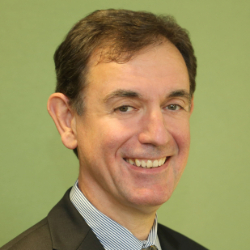
Dr. Ortiz is an American-Spanish scientist specializing in continuum and computational mechanics, with a focus on mathematical tools for the modeling of materials. He earned his BS in civil engineering from the Polytechnic University of Madrid (1977), followed by MS (1978) and Ph.D. (1981) degrees from the University of California, Berkeley, under the supervision of Egor Popov. He began his academic career at Brown University (1984–1995) before joining the California Institute of Technology (Caltech), where he served as the Frank and Ora Lee Marble Professor of Aeronautics and Mechanical Engineering until his retirement in 2020. Dr. Ortiz held the Bonn Research Chair at the Institute for Applied Mathematics, University of Bonn (2016-24), and concurrently served as an adjunct professor and Distinguished Timoshenko Fellow at Stanford University. He is known for developing multiscale modeling techniques, including the quasicontinuum method, and for advancing variational approaches in computational mechanics. His contributions have been recognized with honors such as the Timoshenko Medal (2015), the Rodney Hill Prize (2008), and election to the U.S. National Academy of Engineering (2013).
The authors collaborated on their answers to our questions.
Q: Why are you all excited to receive the award?
A: We are deeply honored to receive the Jerald L. Ericksen Prize, which holds special meaning for us given Ericksen’s groundbreaking contributions to nonlinear elasticity and solid-solid phase transitions. His pioneering ideas have profoundly influenced our work and continue to inspire our research. This award not only acknowledges our contributions but also highlights Ericksen’s enduring legacy in shaping the field.
Q: Could you tell us about the research that won your team the award?
A: Our research focuses on data-driven approaches to modeling how elastic materials deform. Traditional models rely on limited experimental data and empirical assumptions, which can lead to inaccuracies in complex settings. By leveraging rich datasets from modern imaging and microscopy, we aim to develop a new paradigm where material behavior is inferred directly from data, enabling more accurate and predictive models.
Q: What does your team's work mean to the public?
A: Our research offers a new theoretical foundation for simulating material behavior, which can support scientists and engineers in designing next-generation materials and technologies. While the impact on the public is indirect, these advances have the potential to improve safety, efficiency, and sustainability in everyday products. In the long term, this contributes to technological progress with tangible benefits for society.
Q: What does being members of SIAM mean to your team?
A: Engaging with the SIAM community through conferences and events has played a vital role in our research, fostering valuable exchange and collaboration. While we are not currently members, we hold SIAM in the highest regard for its exceptional contributions to applied mathematics and computational science worldwide. Receiving this award is a tremendous honor, and we look forward to deepening our connection with SIAM in the future.
Interested in submitting a nomination for the Jerald L. Ericksen Prize? The prize next opens for nominations on May 1, 2029.
Alex Conway
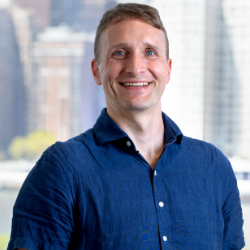
Dr. Alex Conway, Cornell Tech, is the recipient of the 2025 SIAM Activity Group on Applied and Computational Discrete Algorithms Early Career Prize. Dr. Conway received the award “for groundbreaking contributions ranging from theory to practice, in the design, implementation, and application of algorithms and data structures for high-performance memory and storage systems.”
He will be recognized at the 2025 SIAM Conference on Applied and Computational Discrete Algorithms (ACDA25), taking place July 30 – August 1, 2025, and co-located with AN25 in Montréal, Québec, Canada. Dr. Conway will deliver a talk titled "Data Structures for Fast Systems" on Thursday, July 31 at 10:30 a.m. ET.
The SIAM Activity Group on Applied and Computational Discrete Algorithms Early Career Prize is awarded every two years to an outstanding early career researcher in the field of applied and computational discrete algorithms for distinguished contributions to the field in the six calendar years prior to the award year.
Dr. Conway is an assistant professor at Cornell University. Prior to that, he was a senior researcher at VMware Research Group. He received his Ph.D. from Rutgers, The State University of New Jersey, where he was advised by Martín Farach-Colton. His work has primarily focused on randomized data structures and their use in storage and memory systems and covers the full research stack from theory to systems to product. He is the co-creator and research lead of SplinterDB, an enterprise-grade key-value store deployed in VMware products. Learn more about Dr. Conway.
Q: Why are you excited to receive the award?
A: I am honored and excited to receive this award from the SIAM Activity Group on Applied and Computational Discrete Algorithms. My research is driven by the goal of using theoretical computer science to tackle practical challenges, so receiving recognition from this activity group—a group specifically dedicated to this intersection—is especially gratifying. The applied and computational discrete algorithms community has been a fantastic place for exchanging ideas and building a strong network of colleagues, and I'm very much looking forward to presenting my work at the upcoming conference.
Q: Could you tell us about the research that won you the award?
A: The award recognizes my research focused on bridging the gap between theoretical computer science and practical systems, specifically in the design of algorithms and data structures for high-performance memory and storage.
My approach often starts with identifying a new theoretical concept or data structure and exploring how it can be engineered into a real-world system that outperforms existing solutions. A key example of this is SplinterDB. We began with a new, theoretically optimal data structure called the Mapped B-tree, based on purely theoretical work. We then leveraged this theoretical foundation to build a full-fledged, general-purpose key-value store, demonstrating world-class performance on modern hardware. Importantly, this research extended into practice: SplinterDB is now open-source and has been deployed in commercial VMware products like vSAN 8.0, completing the journey from a theoretical idea to practical impact.
Other projects follow this same theory-to-practice pipeline. For instance, Iceberg hash tables use new theoretical insights from load balancing to create exceptionally fast and space-efficient hash tables. We then built upon this, using Iceberg hash tables and another theoretical concept called tiny pointers to create mosaic pages, a novel system for redesigning virtual memory to gain performance benefits without the traditional downsides.
So, broadly, the research recognized by this award involves developing these foundational algorithms and data structures, rigorously analyzing them theoretically, engineering them into high-performance systems, and demonstrating their real-world value in critical areas like data storage and memory management.
Q: What does your work mean to the public?
A: My work focuses on making the fundamental building blocks of computer memory and storage systems faster and more efficient. I achieve this by taking cutting-edge theoretical ideas about organizing data, data structures, and turning them into practical software systems. For the public, this translates into tangible benefits: the applications, websites, and cloud services we use every day rely on these underlying systems to store and retrieve information quickly. By creating innovations like SplinterDB, my research helps make these services faster and more responsive. Similarly, projects like Iceberg hash tables and mosaic pages aim to improve how computers manage memory, which can lead to smoother performance and allow software to handle more complex tasks efficiently. Ultimately, this research contributes to a faster, more capable digital infrastructure which underpins many of the technologies we rely on.
Q: What does being a member of SIAM mean to you?
A: Being a member of SIAM represents being part of the broader community dedicated to applied mathematics and computational science. More specifically, SIAM's activity groups provide venues where researchers tackling similar challenges can connect—in my case, bridging theory and practice in algorithms and systems. The SIAM conferences, and particularly the applied and computational discrete algorithms events, have been essential places to share my research, learn directly from others working on the same topics, and spark new ideas through discussion. Beyond the direct interactions at meetings, I also value SIAM's role in maintaining high-quality venues for disseminating new work in the field.
Interested in submitting a nomination for the SIAM Activity Group on Applied and Computational Discrete Algorithms Early Career Prize? The prize next opens for nominations on May 1, 2026.
Ethan N. Epperly
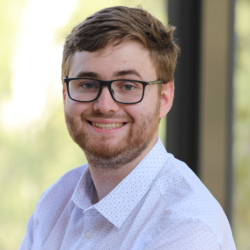
Dr. Ethan N. Epperly, California Institute of Technology, is one of the recipients of the 2025 SIAM Student Paper Prize. He received the award for his paper, “A Theory of Quantum Subspace Diagonalization,” co-authored with Lin Lin, University of California, Berkeley, and Yuji Nakatsukasa, University of Oxford. The paper was published in SIAM Journal on Matrix Analysis and Applications, Vol. 43 (3), pp. 1263 -1290 (2022).
He will be recognized at AN25 and will present the paper in a dedicated session on Thursday, July 31 at 8:00 a.m. ET.
The SIAM Student Paper Prize is awarded annually to the student author(s) of the most outstanding paper(s) accepted by SIAM journals within the three years preceding the nomination deadline. The award is based solely on the merit and content of the student's contribution to the submitted paper. Up to three awards are made every year.
Dr. Epperly's research focuses on developing methods for large-scale computational methods for science and machine learning, with a focus on randomized and quantum algorithms. He received his bachelor's degree from University of California, Santa Barbara's College of Creative Studies (2020), and his doctorate degree in applied and computational mathematics from the California Institute of Technology (2025). He is excited to continue his studies in the summer of 2025 as a Miller Postdoctoral Fellow at the University of California, Berkeley. Learn more about Dr. Epperly.
Q: Why are you excited to receive the award?
A: SIAM journals publish many excellent papers by student authors every year, making it a true honor for my work to my recognized in this way. My deep thanks go to my co-authors and advisor for supporting me in completing this work and to the committee for selecting me.
Q: What does your work mean to the public?
A: In recent years, billions of dollars have been invested in building quantum computers, with governments contributing a substantial share. This raises a pressing question of public interest: What will that investment be good for? How can we harness quantum computers, in the relatively near term, to address societally meaningful problems? My research addresses these questions by critically investigating the performance quantum subspace methods, a promising class of algorithms for solving scientific computing problems on early fault-tolerant quantum devices.
Q: Could you tell us about the research that won you the award?
A: Quantum subspace methods are a class of algorithms for solving very large eigenvalue problems with the help of a quantum computer. These methods are similar in many ways to classical Krylov subspace methods, but also pose unique challenges because they require the solution of a highly ill-conditioned generalized eigenvalue subject to large perturbations to the input matrices. My research shows that, despite these issues, quantum subspace methods can be effective, provided the generalized eigenvalue problem is regularized in an appropriate way.
Q: What does being a member of SIAM mean to you?
A: The old adage warns, “never meet your heroes.” But in my experience, this is bad advice for young, applied mathematicians. By and large, researchers in our field are remarkably kind, generous, and thoughtful, and I’ve been genuinely surprised by how often one of my personal heroes has taken the time to engage in a real conversation with me as a young researcher. Being part of such a warm and welcoming community is the best part of being an applied mathematician—and one of the reasons I’m proud to be a SIAM member.
Interested in submitting a nomination for the SIAM Student Paper Prize? The prize next opens for nominations on September 15, 2025.
S. Rasoul Etesami
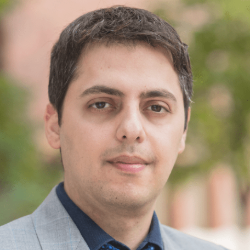
Dr. S. Rasoul Etesami, University of Illinois Urbana-Champaign, is one of the recipients of the 2025 SIAM Activity Group on Control and Systems Theory Best SICON Paper Prize. He received the award “for his paper ‘Learning Stationary Nash equilibrium policies in n-player stochastic games with independent chains,’ published in SIAM Journal on Control and Optimization, Vol. 62 (2), pp. 799 - 825 (2024), for its innovative approach, depth of the analysis, and significance of the results in the realm of strategic multi-agent decision-making under uncertainty.”
He will be recognized at the 2025 SIAM Conference on Control and Its Applications (CT25), taking place July 28 – 30, 2025, and co-located with AN25 in Montréal, Québec, Canada. Dr. Etesami will present the paper on Monday, July 28 at 11:30 a.m. ET.
The SIAM Activity Group on Control and Systems Theory Best SICON Paper Prize is awarded every two years to the authors of the two most outstanding papers, as determined by the prize committee, published in SICON in the three calendar years preceding the award year.
Dr. Etesami is an associate professor in the Department of Industrial and Systems Engineering and affiliated with the Department of Electrical and Computer Engineering department and the Coordinated Science Laboratory, at the University of Illinois Urbana-Champaign (UIUC). He received his Ph.D. in electrical and computer engineering from UIUC (2015) and was a postdoctoral research fellow in the Department of Electrical and Computer Engineering at Princeton University and WINLAB at The State University of New Jersey (2016-17). His research interests include the analysis of complex socioeconomic and decision-making systems using tools from control theory, game theory, optimization, and learning theory. He was the recipient of the Best Coordinated Science Laboratory Ph.D. Thesis Award at UIUC (2016), the Springer Outstanding Ph.D. Thesis Award (2017), the NSF CAREER Award (2020), and the Air Force Young Investigator Award (2023). Learn more about Dr. Etesami.
Q: Why are you excited to receive the award?
A: I am truly humbled to receive this award, as it not only recognizes the dedication that has gone into my research but also fuels my enthusiasm to continue tackling important future problems in the field. The recognition serves as a reminder of the impact that thoughtful, rigorous inquiry can have on advancing knowledge and solving real-world challenges. This award motivates me to continue striving for innovation and to contribute meaningfully to future advancements that have the potential to create a lasting impact.
Q: Could you tell us about the research that won you the award?
A: Efficient and independent learning of Nash equilibria (NE) in strategic multi-agent decision-making systems presents a significant challenge in many fields. In such systems, an immediate goal for the agents, or players, is to adaptively make decisions that optimize their own payoff functions. However, since the players’ payoff functions may be misaligned, their decisions may not result in a NE—a stable outcome in which each player’s decision optimizes their own payoff given the fixed decisions of the others. Therefore, a major question in this area is: Can players learn to update their strategies through interactions so that their collective decisions converge to a NE? Moreover, the convergence time to a NE should be short and scale polynomially with respect to the game parameters, and players’ decisions must be made independently and without coordination. Thus, convergence, scalability, and independence are three major challenges in the efficient learning of NE points in large-scale noncooperative games. To address this question, this research paper makes a major contribution by developing scalable learning algorithms for computing NE policies within the class of payoff-coupled stochastic games with independent chains. It introduces efficient decentralized learning dynamics for computing stationary NE policies and shows that, under some mild assumptions, the proposed learning dynamics converge almost surely or in expectation to a stationary NE policy, with non-asymptotic polynomial-time convergence rates.
Q: What does your work mean to the public?
A: This work addresses key challenges with direct implications for the public by developing computational models that impact problems in communication, resource allocation, and decision-making among large groups of users. Specifically, this research focuses on novel learning algorithms that can inform the creation of new strategies for optimizing systems such as network security, energy management in smart grids, and bandwidth allocation in wireless networks. For instance, in smart grids, the proposed algorithms will enable users to efficiently interact with utility companies and one another to learn equilibrium energy consumption and production strategies, promoting better resource distribution. In wireless communication, the research offers scalable mechanisms that allow data senders to optimize their transmission power based on observed payoffs and data queue conditions, thereby reducing communication traffic and enhancing the overall quality and reliability of the network.
Q: What does being a member of SIAM mean to you?
A: SIAM is one of my favorite scientific communities and has consistently fulfilled its promise of publishing high-quality research over the years. SIAM’s journals and conference proceedings provide outstanding platforms for disseminating research across a wide range of disciplines and topics, ensuring that new ideas and advancements are shared with the broader scientific community. The society is highly respected among researchers worldwide, and I consider it one of my top priorities to contribute my best work to it. Being a member of SIAM, surrounded by many esteemed members, is truly an honor, and it continues to inspire me to strive for excellence in my research.
Interested in submitting a nomination for the SIAM Activity Group on Control and Systems Theory Best SICON Paper Prize? The prize next opens for nominations on May 1, 2026.
Carles Falcó
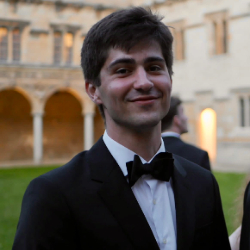
Carles Falcó, University of Oxford, is one of the recipients of the 2025 SIAM Student Paper Prize. He received the award for his paper, “A Local Continuum Model of Cell-Cell Adhesion,” co-authored with Ruth E. Baker and José A. Carrillo, University of Oxford. The paper was published in SIAM Journal on Applied Mathematics, Vol. 84 (3), pp. S17 - S42 (2024).
The SIAM Student Paper Prize is awarded annually to the student author(s) of the most outstanding paper(s) accepted by SIAM journals within the three years preceding the nomination deadline. The award is based solely on the merit and content of the student's contribution to the submitted paper. Up to three awards are made every year.
Carles Falcó completed a double degree in physics and mathematics at the Universitat Autònoma de Barcelona, graduating in 2021. He is now in the fourth and final year of his DPhil in mathematical biology at the University of Oxford, under the supervision of Ruth Baker and José A. Carrillo. His research combines mathematical modelling and inference to understand complex phenomena at the cell and tissue level. In October 2025, he will begin as a Hooke Research Fellow at the Oxford Mathematical Institute. Learn more about Carles.
Q: Why are you excited to receive the award?
A: I’m incredibly happy and honored to receive this award. It’s a real validation of our work and motivates me to continue exploring these topics, especially refining and applying the model we’ve developed to new problems in mathematical biology.
Q: What does your work mean to the public?
A: Our models describe how individual entities, whether cells in a developing embryo, animals in a swarm or people in a crowd, self-organize into coherent patterns. They help us understand how cells use basic mechanisms, such as adhesion, to sort themselves into complex patterns. By translating complex, long-range interactions into a simpler local form, we make it easier and faster to simulate and predict collective behavior. This has broad implications: from guiding tissue-engineering and understanding embryonic development, to informing ecological conservation of species.
Q: Could you tell us about the research that won you the award?
A: We show how models with nonlocal interactions, often costly to simulate, admit an equivalent, fourth-order local formulation akin to Cahn–Hilliard equations. This local limit retains the key phenomenology of cell-sorting patterns arising from differential adhesion, while greatly simplifying numerical implementation. Our work builds a rigorous bridge between nonlocal and local models, facilitates quantitative calibration against experiments, and has already inspired further analytical and numerical studies in two-species aggregation and degenerate Cahn–Hilliard theory.
Q: What does being a member of SIAM mean to you?
A: Being a SIAM member has been a real highlight of my doctoral studies. I’ve enjoyed attending several SIAM conferences and publishing in SIAM journals, and on multiple occasions I’ve received SIAM funding to facilitate scientific exchange and present my research. The SIAM community is truly interdisciplinary and has provided an excellent platform for networking, learning, and sharing ideas across fields.
Interested in submitting a nomination for the SIAM Student Paper Prize? The prize next opens for nominations on September 15, 2025.
Tamara G. Kolda
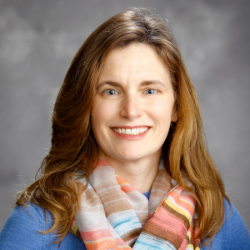
Dr. Tamara G. Kolda, MathSci.ai, is the 2025 recipient of the SIAM Prize for Distinguished Service to the Profession and will be recognized at AN25. She received the award “in recognition of her extensive leadership and service to multiple applied mathematics communities, including SIAM and National Academies, and promotion of equity, diversity, and inclusion.”
SIAM awards the Prize for Distinguished Service every year to an applied mathematician who has made distinguished contributions to the furtherance of applied mathematics on the national or international level.
Dr. Kolda, Ph.D., is an independent mathematical consultant under the auspices of her California-based company MathSci.ai, founded in 2021. She worked as a researcher at Sandia National Laboratories in Livermore, California (1999-2021). Prior to that, she held the Householder Postdoctoral Fellowship at Oak Ridge National Laboratory. Her research is in the broad domain of mathematical data science, spanning tensor decompositions, randomized algorithms, network science, machine learning, optimization, graph algorithms, linear algebra, high performance computing, and mathematical software. She has authored 75+ journal articles, conference proceedings papers, and book chapters as well as two books. She is a member of the U.S. National Academy of Engineering, a 2015 SIAM Fellow, and Fellow of the Association for Computing Machinery. She currently serves as SIAM Vice President for Publications and Chair of the SIAM Activity Group on Equity, Diversity, and Inclusion. Learn more about Dr. Kolda.
Q: Why are you excited to receive the award?
A: It is an honor to be recognized for my service to SIAM and the applied mathematics community. I am deeply aware of how much I have benefited from the contributions of others in our field, and it has been my privilege to pay it forward. I am humbled to be in the company of the past recipients of this prize, luminaries who have directly and indirectly impacted my own trajectory and served as my career role models. I extend my sincere gratitude to SIAM for this award.
Q: Could you tell us about the research that won you the award?
A: Mathematics has a serious marketing problem – even academic mathematicians do not seem to recognize its importance to the public!
I was fortunate to chair an all-star National Academies committee on “Illustrating the Impact of Mathematics.” The result was ten graphical posters that explain various topics in the mathematical sciences, broadly defined. These include posters explaining the role of math in securing the internet (cryptography, robust signals); computing commutes (navigation, routing); imaging (microscopy, telescopes, medical imaging); precision medicine (cancer treatments, heart simulations); manufacturing (design, assembly, delivery); weather forecasting (models, data assimilation); and artificial intelligence (efficiency, model selection). My favorite posted by far, originally conceived by Terry Tao, is titled “Math is the Hero,” showcasing the many ways that math impacts our daily lives. My hope is that these posters will help more students become interested in mathematics and also showcase the importance of mathematical work to funding agencies and companies.
As proud as I am of the work of that committee, it has only shown me how much is left to do. I hope to continue to find ways to dismantle barriers between applied mathematics and the public as well as between different fields and subfields. I am inspired every time I see someone write an article or post a video to educate a broader audience about topics in mathematical sciences, especially in applied mathematics.
Q: What does your work mean to the public?
A: SIAM’s citation has graciously listed a variety of activities that I’ve been involved with over the years. The theme of my service work has been expanding our community to encompass everyone passionate about applied mathematics. I’ll focus on two examples
(1) With the help of Joel Tropp and several others, I led the development of the SIAM Journal on Mathematics of Data Science. The goal was to make mathematical data science a major focus area of SIAM and to highlight the key role of mathematics in data science. The ripple effects within SIAM have included the launch of the SIAM Conference on Mathematics of Data Science and the reorganization of the SIAM Activity Group on Data Mining into the SIAM Activity Group on Data Science. More generally, I hope we have established a welcoming home for those who are thinking deeply about the mathematical underpinnings of machine learning and artificial intelligence.
(2) I led the formation of the SIAM Activity Group on Equity, Diversity, and Inclusion, joining forces with the embryotic efforts of Suzanne Sindi and others working towards the same goal. Our goal here is to ensure that the field of applied mathematics enables talented and passionate individuals of all stripes to thrive and find purpose. Especially during these times, I hope we can provide resources and hope to those who share the dream of making our field welcoming to all comers and nurturing talent in all its forms.
Q: What does being a member of SIAM mean to you?
A: I have become only more impressed with SIAM over the years: It is steadfastly dedicated to its members and its mission of promoting the field. SIAM’s conferences and publications have been essential for sharing my research and creating professional connections. SIAM has also played in my leadership development, including through mentorship from more senior SIAM members. Each new role within SIAM has given me a new vantage point on our field and its future. Most importantly, SIAM is my professional home. While our careers may take us from place to place, SIAM remains a constant. I truly appreciate the many great friends and colleagues that I have through my membership in SIAM.
Interested in recommending someone for the SIAM Prize for Distinguished Service to the Profession? Suggest a recipient!
Paul Manns and Annika Schiemann
Dr. Paul Manns and Dr. Annika Schiemann, Technische Universität Dortmund (TU Dortmund), are two of the recipients of the 2025 SIAM Activity Group on Control and Systems Theory Best SICON Paper Prize. The pair received the award “for their paper ‘On Integer Optimal Control with Total Variation Regularization on Multidimensional Domains,’ published in SIAM Journal on Control and Optimization, Vol. 61 (6), pp. 3415 - 3441 (2023) for its innovative research, mathematical difficulty, and interest in its potential applications.”
They will be recognized at the 2025 SIAM Conference on Control and Its Applications (CT25), taking place July 28 – 30, 2025, and co-located with AN25 in Montréal, Québec, Canada. Dr. Manns will present the paper on Monday, July 28 at 11:55 a.m. ET.
The SIAM Activity Group on Control and Systems Theory Best SICON Paper Prize is awarded every two years to the authors of the two most outstanding papers, as determined by the prize committee, published in SICON in the three calendar years preceding the award year.
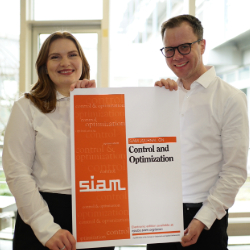
Dr. Manns is an associate professor at TU Dortmund, specializing in integer optimization in infinite-dimensional spaces and trust-region algorithms. He earned his MSc in computational engineering from TU Darmstadt (2015) and earned his Ph.D. at TU Braunschweig (2019). Dr. Manns also was the James H. Wilkinson Fellow at Argonne National Laboratory (2020-21). He subsequently joined TU Dortmund University as an assistant professor, where he continues to advance the field of computational optimization through both theoretical and applied research.
Dr. Schiemann is a postdoctoral researcher at TU Dortmund. She earned her MSc in mathematics from TU Dortmund (2020) and earned her Ph.D. at TU Dortmund (2024). Her research focus lies on the numerical analysis of discrete-valued functions in the space of functions of bounded variation.
Q: Why are you all excited to receive the award?
A: The results presented in the award-winning article were exceptionally challenging to achieve. They required an intensive and time-consuming exploration of several mathematical areas that were entirely new to us. Seeing this hard work recognized is incredibly gratifying. Moreover, the research has proven to be groundbreaking, laying the foundation for further important publications and research projects.
Q: Could you tell us about the research that won your team the award?
A: We integrated several areas of mathematics to analyze a trust-region algorithm for infinite-dimensional optimization problems involving discrete-valued variables—a class of problems that inherently lacks a vector space structure. We proved that the algorithm converges to points satisfying a first-order optimality condition. These results were established using advanced techniques from the theories of geometric variational problems and trust-region algorithms.
Q: What does your team's work mean to the public?
A: We’ve developed a highly versatile algorithm that, in principle, can be applied to a wide range of problems—from image segmentation to designing advanced scattering devices. Now that the theoretical groundwork is in place, we’re focusing on building efficient and scalable implementations, with guarantees on how closely they approximate the optimal solution.
Q: What does being members of SIAM mean to your team?
A: SIAM’s journals and conferences connect theoretical research, practical applications, and industry professionals in a unique way. After achieving our results, we knew we wanted to publish them in the SIAM Journal on Control and Optimization, which holds a strong reputation in our field. Beyond publishing, SIAM also stands out for its excellent networking opportunities and its commitment to diversity, equity, and inclusion, which are important to advance our discipline.
Interested in submitting a nomination for the SIAM Activity Group on Control and Systems Theory Best SICON Paper Prize? The prize next opens for nominations on May 1, 2026.
Mason A. Porter
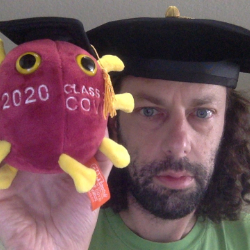
Dr. Mason A. Porter, University of California, Los Angeles (UCLA), is the recipient of the 2025 George Pólya Prize for Mathematical Exposition and will be recognized at AN25. Dr. Porter received the award “for his outstanding exposition of the mathematical sciences to audiences at all levels and interests, including review articles in networks, complex systems and dynamics.”
The George Pólya Prize for Mathematical Exposition, established in 2013, is awarded every two years to an outstanding expositor of the mathematical sciences. The prize may be awarded for a specific work or for the cumulative impact of multiple expository works that communicate mathematics effectively. Following Pólya’s example, the nature of the work may range from popular accounts of mathematics and mathematical discovery to pedagogy to systematic organization of mathematical knowledge.
Dr. Porter is a professor in the Department of Mathematics at UCLA, with a secondary appointment in the Department of Sociology, and is an external professor at the Santa Fe Institute. He earned his B.S. in applied mathematics at the California Institute of Technology (1998) and his Ph.D. from the Center for Applied Mathematics at Cornell University (2002). After postdoctoral positions at the Georgia Institute of Technology, the Mathematical Sciences Research Institute, and the California Institute of Technology, Dr. Porter joined the faculty in the Mathematical Institute at University of Oxford (2007). He then moved to UCLA (2016). He studies many topics in complex systems, networks, and nonlinear systems. Thus far, twenty-nine Ph.D. students have completed their doctorates under Dr. Porter’s mentorship. He has also mentored many postdoctoral scholars and undergraduate students. In 2017, Dr. Porter received the Council on Undergraduate Research Faculty Mentoring Award in the advanced career category within the Mathematics and Computer Science Division (2017). He is also a 2019 SIAM Fellow, an American Mathematical Society Fellow, and an American Physical Society Fellow. Learn more about Dr. Porter.
Q: Why are you excited to receive the award?
A: Mathematical exposition means a lot to me, so it's really wonderful to receive this type of recognition for it. I have great admiration for many of the prior winners of this prize, and I feel very honored to join them. Additionally, in these dystopian days, any sane person can use all of the good news they can get.
Q: Could you tell us about the research that won you the award?
A: I was awarded this prize for my mathematical exposition for diverse audiences. This body of work encompasses many different types of works — research articles, review articles, books, articles for a general mathematics audience, articles for teenagers and preteens, and others — in subjects such as networks, complex systems, and nonlinear dynamics.
Q: What does your work mean to the public?
A: The importance of mathematical exposition has many audiences, including both scholars and members of the general public. Hopefully, the more public-facing work that I have done, such as my articles about mathematics for teenagers and preteens, is something that many members of the public can appreciate. I want them to see the joy of applied mathematics. I also want them to see that mathematics is useful, but I actually care more about them developing a sense of joy for mathematics.
Q: What does being a member of SIAM mean to you?
A: SIAM is my home community in science, and I really enjoy being a part of it. Whenever I go to a SIAM conference, I see many old friends. Applied mathematicians — and most certainly myself included — are caught between many different worlds. It's the best and most interesting place to be, and we can be in it together!
Interested in submitting a nomination for the George Pólya Prize for Mathematical Exposition? The prize next opens for nominations on May 1, 2026.
Alfio M. Quarteroni
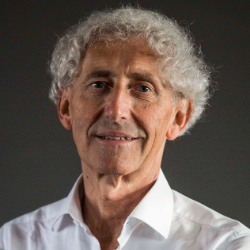
Dr. Alfio M. Quarteroni, Politecnico di Milano and the École Polytechnique Fédérale de Lausanne (EPFL), is the recipient of the 2025 Ralph E. Kleinman Prize and will be recognized at AN25. Dr. Quarteroni received the award “for his exceptional contributions to mathematical modelling, scientific computing, computational fluid dynamics, machine learning, profound impact on a wide range of applications, and outstanding leadership in bringing mathematics into practice.”
The Ralph E. Kleinman Prize is awarded every two years to one individual for outstanding research or other contributions that bridge the gap between mathematics and applications. Work that uses high-level mathematics and/or invents new mathematical tools to solve applied problems from engineering, science, and technology is particularly appropriate.
Dr. Quarteroni is an Emeritus Professor at Politecnico di Milano, Italy, and at EPFL, Lausanne, Switzerland. He is the founder of MOX and co-founder of MOXOFF, a spin-off company at Politecnico di Milano. Dr. Quarteroni is a member of several prestigious academies, including the Accademia Nazionale dei Lincei, the European Academy of Sciences, the Academy of Europe, the Lisbon Academy of Sciences, and the Italian Academy of Engineering and Technology. He has authored 25 books and more than 400 research papers. Dr. Quarteroni has been honored with numerous awards, including the NASA CFD Award (1992), the International Galileo Galilei Prize for Sciences (2015), the European Community on Computational Methods in Applied Sciences (ECCOMAS) Euler Medal (2022), the International Council for Industrial and Applied Mathematics Lagrange Prize (2023), the Blaise Pascal Prize for Mathematics (2024), and the ECCOMAS Ritz-Galerkin Medal (2024). He is a 2009 SIAM Fellow, a 2004 International Association of Computational Mechanics Fellow, and honorary member of ECMI. He’s also a member of the Fields Medal Committee (2022-present). Learn more about Dr. Quarteroni.
Q: Why are you excited to receive the award?
A: I am truly honored to have my work recognized with the Ralph E. Kleinman Prize. I feel incredibly fortunate to have collaborated with so many talented students, postdocs, and colleagues, whose support has been instrumental in advancing my research over the years. Having spent my career bridging applied mathematics, numerical analysis, and scientific computing, it is especially meaningful to be acknowledged by an award that celebrates interdisciplinary work that bridges the gap between mathematics and applications.
Q: Could you tell us about the research that won you the award?
A: My research interests span mathematical modeling, numerical analysis, scientific computing, and their applications in fluid mechanics, geophysics, medicine, and sports performance enhancement. Over the past 15 years, I have specialized in the numerical approximation of complex problems in fluid mechanics, aerospace engineering, geophysics, acoustics, and seismic wave propagation. Additionally, I have contributed to the development of reduced basis methods, which simplify the solution of partial differential equations, as well as to solving optimal control problems for these equations. I have also explored scientific machine learning, focusing on innovative ways to combine data-driven algorithms with physics-based numerical models. Beyond these areas, I have applied mathematical modeling to architectural landscape design and worked on improving sports performance in fields like Olympic rowing, swimsuits, volleyball, and soccer. My research group at EPFL has contributed to the preliminary design of Solar Impulse, the Swiss long-range solar-powered aircraft, and has provided mathematical simulations to optimize the performance of the Alinghi yacht, winner of the America’s Cup in 2003 and 2007. However, my primary focus has been the development of a comprehensive mathematical model to simulate cardiac function. Together with my iHEART team at Politecnico di Milano, I am proud to say that we are at the forefront of global research in this exciting and challenging field.
Q: What does your work mean to the public?
A: My work in optimizing sports performance and the resulting successes have garnered significant worldwide media attention. The numerous collaborations with doctors and cardiologists in hospitals across various European countries have contributed to improving diagnoses and optimizing surgical operations for treating heart diseases, which have a major impact on public health. In both fields, we have been able to demonstrate that mathematics today allows us to tackle and overcome challenges of great interest and significant impact on our society. I am also particularly proud to have written several scientific books that have gained widespread use in academic settings. One of my greatest sources of pride is meeting students across all five continents who confess to having studied from my books and sharing the impact they have had on their education and, often, their careers.
Q: What does being a member of SIAM mean to you?
A: I am deeply passionate about leveraging mathematics and scientific computing to amplify the positive impact of applied sciences and engineering on the world. Equally, I am committed to teaching, mentoring, and educating the next generation of interdisciplinary problem solvers. SIAM’s open-minded and interdisciplinary community has been integral to pursuing these passions throughout my career. What I appreciate most about SIAM is its ability to unite individuals from diverse fields, with mathematics at the core, yet free from rigid disciplinary boundaries. SIAM fosters collaboration across academia, industry, and government/national labs, all while maintaining high standards in scholarly publishing. Furthermore, I deeply value its dedication to nurturing the next generation of researchers and practitioners. Having served for several years on the SIAM Advisory Board, I have come to truly appreciate the rigor, efficiency, tradition, and vision of this organization. SIAM is truly a family where applied mathematicians from all corners of the world can feel safely at home.
Interested in submitting a nomination for the Ralph E. Kleinman Prize? The prize next opens for nominations on May 1, 2026.
Oded Stein
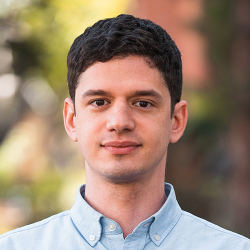
Dr. Oded Stein, University of Southern California, is the recipient of the 2025 SIAM Activity Group on Geometric Design Early Career Prize. Dr. Stein received the award “for advancing the field of geometry processing through robust algorithms based on improved energies within variational methods, thorough mathematical analysis, and novel discretization schemes.”
He will be recognized at the 2025 SIAM Conference on Computational Geometric Design (GD25), taking place July 28 – 30, 2025, and co-located with AN25 in Montréal, Québec, Canada. Dr. Stein will deliver a talk titled “Robust and Sustainable Geometry Processing” on Wednesday, July 30 at 11:30 a.m. ET.
The SIAM Activity Group on Geometric Design Early Career Prize is awarded every two years to an early career researcher who has made outstanding, influential, and potentially long-lasting contributions within five years of receiving the Ph.D. or equivalent degree as of January 1 of the award year. At least one of the papers containing this work must be published in English in a peer-reviewed journal or conference proceedings.
Dr. Stein is an assistant professor at the University of Southern California Viterbi School of Engineering, supported by the National Science Foundation. He received his Ph.D. from Columbia University in applied mathematics (2020), under the supervision of Eitan Grinspun for his research of smoothness energies in geometry processing. He also was a postdoctoral fellow at Massachusetts Institute of Technology’s Computer Science and Artificial Intelligence Laboratory (2020-22) with the gracious support of the Swiss National Science Foundation’s Early Postdoctoral Mobility Fellowship. Learn more about Dr. Stein.
Q: Why are you excited to receive the award?
A: I am very happy to receive this SIAM award. Being recognized at this early stage of my career for my work on the intersection of mathematics and computer science is both an honor and a strong affirmation of the impact of geometric data processing on current computing applications. My research has focused on enhancing the robustness, accessibility, and sustainability of these methods, and this award will inspire me to continue my work in these areas. I am grateful for the opportunity to contribute to research efforts in this exciting field.
Q: Could you tell us about the research that won you the award?
A: Many geometry processing applications can be hindered by robustness issues or require an extensive amount of input data to perform effectively. This means that if methods don't work on all inputs correctly, they can crash, or they can fail to produce the expected result. My work aims to improve such methods by researching and documenting the conditions for which certain algorithms and methods work, by creating algorithms that are guaranteed to work under certain conditions, and by creating methods that make do with a small amount of input data. These contributions enhance the overall robustness and accessibility of geometry processing methods.
Q: What does your work mean to the public?
A: The public interacts with geometry processing methods in many places, both as professionals and as laypeople. Professionals in fields such as engineering, design, and animation employ computer aided design and 3D modeling software to create and manipulate shapes. Laypeople design shapes for 3D printing, use virtual reality applications, or use generative AI applications. My work contributes to making all of these applications more robust, more accessible, and more sustainable.
Q: What does being a member of SIAM mean to you?
A: I am looking forward to becoming a member of SIAM. SIAM and its meetings have the potential to foster important collaborations and networking opportunities with other applied mathematicians.
Interested in submitting a nomination for the SIAM Activity Group on Geometric Design Early Career Prize? The prize next opens for nominations on May 1, 2026.
Marius Tucsnak
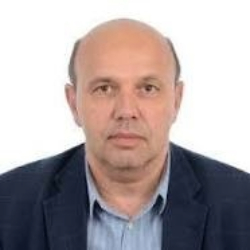
Dr. Marius Tucsnak, University of Bordeaux, is the recipient of the 2025 W. T. and Idalia Reid Prize. He received the award “for his fundamental work on the mathematical analysis and control of fluid-structure interaction and for his deep contributions to control theory and partial differential equations.” Dr. Tucsnak will deliver a lecture at AN25 titled “Reachable Spaces for Infinite Dimensional Linear Systems” on Tuesday, July 29 at 2:00 p.m. ET.
The W. T. and Idalia Reid Prize is awarded annually to one individual for research in, or other contributions to, the broadly defined areas of differential equations and control theory.
Dr. Tucsnak is a distinguished professor of mathematics at the University of Bordeaux, France. He earned his M.Sc. in mathematics-mechanics from Bucharest University, Romania, and completed his Ph.D. in applied mathematics at the University of Orleans, France (1992). In 1996, he received his "Habilitation" from the University Pierre et Marie Curie, Paris.
Throughout his illustrious career, Dr. Tucsnak has received numerous accolades. He was an invited speaker at the International Congress of Mathematicians (2022) and was awarded the Spiru Haret Prize by the Romanian Academy (2018). Additionally, he has been twice honored as a senior member of the Institut Universitaire de France (2013-18; 2024-29).
Dr. Tucsnak’s research focuses on the analysis and control of systems governed by partial differential equations, with particular attention to fluid-structure interactions. He has authored over 100 research papers and co-authored the monograph "Observation and Control for Operator Semigroups" with George Weiss. Learn more about Dr. Tucsnak.
Q: Why are you excited to receive the award?
A: I am truly honored to receive the W. T. and Idalia Reid Prize, the most prestigious award for mathematicians in the field of control theory, particularly for those working with systems described by partial differential equations. This recognition not only highlights the significance of my research but also connects me with a distinguished lineage of esteemed scientists who have been awarded this honor over the past decades.
Q: What does your work mean to the public?
A: From the beginning of my career, my research has been driven by real-world challenges, ranging from identifying the properties of materials used in the textile industry to understanding the fluid dynamics of swimming in aquatic organisms. A central focus of my work is the development of control laws that guide these systems toward desired outcomes, whether it's optimizing the time required to reach a specific state or enhancing their overall performance.
Q: Could you tell us about the research that won you the award?
A: This prize recognizes my research in the mathematical analysis and control of fluid-structure interactions, as well as my contributions to control theory and partial differential equations. One notable achievement in my work on fluid-structure interactions is the establishment of the first global-in-time existence result for the partial differential equation system that models the motion of a rigid body within a viscous fluid contained in a bounded container. A highlight of my recent research in control theory is my work on reachable spaces and time-optimal control for systems described by parabolic partial differential equations.
Q: What does being a member of SIAM mean to you?
A: I am truly grateful to SIAM for the invaluable opportunities it offers to engage with colleagues from around the globe through its organized conferences. My contributions as both an author and an associate editor for SIAM Journal on Control and Optimization have further enriched this experience. I still vividly remember presenting some of my earliest significant results at the 1991 SIAM Conference on Control and Its Applications in Washington, D.C. Receiving the W. T. and Idalia Reid Prize 34 years later is a profound honor that reflects my ongoing commitment to the field and the connections I have fostered through SIAM.
Interested in submitting a nomination for the W. T. and Idalia Reid Prize? The prize is currently accepting nominations until October 15, 2025.
Henk van Waarde
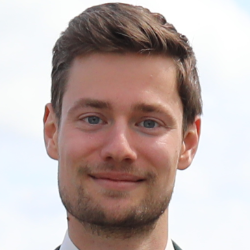
Dr. Henk van Waarde, University of Groningen, is the recipient of the 2025 SIAM Activity Group on Control and Systems Theory Prize. He received the award “for his work on data informativity and his fundamental contributions to data-driven control, network identification and structural system analysis impacting many relevant subfields.”
Dr. van Waarde will be recognized at the 2025 SIAM Conference on Control and Its Applications (CT25), taking place July 28 – 30, 2025, and co-located with AN25 in Montréal, Québec, Canada. Brayan Shali, Katholieke Universiteit Leuven, will deliver the prize talk on his behalf. The talk is titled “Bridging Physical and Data: Kernel-based Modelling of Positive Dynamical Systems” and will be given on Tuesday, July 28 at 11:30 a.m. ET.
The SIAM Activity Group on Control and Systems Theory Prize is awarded every two years to one outstanding early career researcher for distinguished contributions to mathematical theory of systems and control in the three calendar years preceding the award year.
Dr. van Waarde is an assistant professor within the Bernoulli Institute for Mathematics, Computer Science and AI at the University of Groningen, The Netherlands. From 2020-2021, he was a postdoctoral researcher, first at the University of Cambridge, and later at ETH Zürich, Switzerland. He obtained his Ph.D. degree cum laude in applied mathematics from the University of Groningen (2020). He was also a visiting researcher at the University of Washington (2019-20). Dr. van Waarde's research aims at developing mathematical systems and control theory grounded in data. In particular, he works on topics related to data-driven control, experiment design, and system identification, with applications to networked systems and neuromorphic computing. He is an associate editor of the IEEE Control Systems Letters. Learn more about Dr. van Waarde.
Q: Why are you excited to receive the award?
A: I am very grateful and honored to receive this award. It is for a topic that I love working on, and it is really encouraging that my research was recognized by the community.
Q: Could you tell us about the research that won you the award?
A: I started to become interested in data-driven control at the end of 2018. Around that time, a direction that was gaining momentum was the design of controllers directly from measured data, without the usual intermediate step of system identification. My research was motivated by the question to what extent direct data-driven control could outperform the combination of system identification and model-based control. Together with colleagues from Groningen, I developed a theoretical framework that we called the informativity approach. The idea was to investigate conditions under which given data contain sufficient information for control design, for a variety of control objectives. One of the key insights was that the conditions for data-driven stabilization are weaker than those for system identification, thus revealing that direct data-driven control is more powerful than the indirect approach to this problem. On the other hand, for problems like linear quadratic regulation, the conditions boil down to those for system identification, meaning that in this case direct and indirect approaches are equivalent. In addition to these results, I have also developed a set of mathematical tools that allow the design of data-driven controllers from noise-corrupted data, while retaining guarantees on stability and performance.
Q: What does your work mean to the public?
A: Due to a wide availability of low-cost sensor devices, data is nowadays abundant. Using these data in clever ways can help us to develop control algorithms for many complex engineering systems like power grids and wind farms. My research provides mathematical guarantees for the performance of such data-driven controllers, which is a crucial prerequisite for safely applying these methods in practice.
Q: What does being a member of SIAM mean to you?
A: I am thankful to SIAM for bringing together a group of applied mathematicians. The SIAM journals are some of the best in our field, and I have fond memories of past SIAM conferences. In fact, one of my current ongoing collaborations is due to a connection made at one of the SIAM conferences.
Interested in submitting a nomination for the SIAM Activity Group on Control and Systems Theory Prize? The prize next opens for nominations on May 1, 2026.
Peter A. Whalley
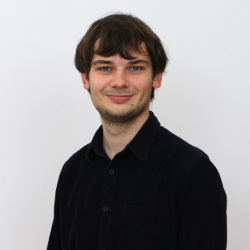
Dr. Peter A. Whalley, ETH Zürich, is one of the recipients of the 2025 SIAM Student Paper Prize. He received the award for his paper, “Contraction and Convergence Rates for Discretized Kinetic Langevin Dynamics”, co-authored with Benedict J. Leimkuhler and Daniel Paulin, University of Edinburgh. The paper was published in SIAM Journal on Numerical Analysis, Vol. 62 (3), pp. 1226 - 1258 (2024).
He will be recognized at AN25 and will present the paper in a dedicated session on Thursday, July 31 at 8:00 a.m. ET.
The SIAM Student Paper Prize is awarded annually to the student author(s) of the most outstanding paper(s) accepted by SIAM journals within the three years preceding the nomination deadline. The award is based solely on the merit and content of the student's contribution to the submitted paper. Up to three awards are made every year.
Dr. Whalley is a postdoctoral researcher in the Seminar for Statistics at ETH Zürich. He received his bachelor's degree from Imperial College London (2019), his master's degree from the University of Oxford (2020), and his Ph.D. in applied mathematics from the University of Edinburgh (2024). His research focuses on stochastic numerics and Markov chain Monte Carlo methods, with applications in optimization, Bayesian computation, and statistical physics. Learn more about Dr. Whalley.
Q: Why are you excited to receive the award?
A: I am honored to receive the SIAM Student Paper Prize. The work in this paper laid the foundation for several research projects during my doctorate, and I am very happy that it has been recognized with this award.
Q: What does your work mean to the public?
A: This work investigates the stability, convergence, and accuracy of numerical methods used for sampling, which play a central role in molecular simulation and Bayesian inference. By understanding how different methods perform and how their parameters affect results, we can make more informed choices that improve both the efficiency and accuracy of computations. These insights have already led to practical improvements—for example, in training neural networks more effectively and in accurately modelling phase transitions in complex particle systems.
Q: Could you tell us about the research that won you the award?
A: The paper investigates the Wasserstein convergence of discrete-time stochastic processes, focusing on kinetic or underdamped Langevin dynamics methods, which are widely used for efficient sampling in Bayesian inference and molecular simulation. Using a contractivity argument, we established sharp convergence rates in Wasserstein distance for several common discretization schemes. These rates explicitly depend on parameters such as the friction coefficient, strong convexity constant, and smoothness of the potential. We also derived second-order Wasserstein bias estimates for a widely used numerical method, comparing it to a modified dynamics that preserves the invariant measure. These results clarify how step size and algorithm parameters affect both convergence and long-time bias, providing guidance for practical method selection.
Q: What does being a member of SIAM mean to you?
A: Being a member of SIAM means being part of a broad and active community in applied mathematics. I especially value the diversity of topics covered across its journals, which reflect the wide reach of modern applied and computational mathematics.
Interested in submitting a nomination for the SIAM Student Paper Prize? The prize next opens for nominations on September 15, 2025.
Yongjie Jessica Zhang
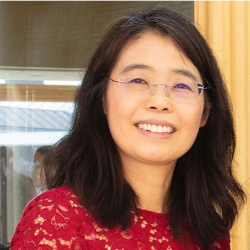
Dr. Yongjie Jessica Zhang, Carnegie Mellon University, will deliver the 2025, is the recipient of the 2025 AWM-SIAM Sonia Kovalevsky Lecture. Dr. Zhang is a distinguished scholar renowned for her pioneering work in computational geometry and finite element methods, with profound impacts across biomedical and engineering applications. As a professor at Carnegie Mellon University, she has advanced meshing techniques that enable precise simulations in complex domains that appear in medical imaging and biological modeling. Dr. Zhang's innovative research on isogeometric analysis has set new standards in numerical accuracy and computational efficiency. Her numerous publications, leadership roles, and accolades, including her status as a fellow of several scientific societies, underscore her dedication to advancing the field and inspiring the next generation of computational scientists.
This year’s Kovalevsky Lecture, titled “From Neurological Disorders to Additive Manufacturing: Integrating Isogeometric Analysis with Deep Learning and Digital Twins”, will take place on Monday, July 28 at 2:45 p.m. ET.
The Association for Women in Mathematics (AWM) and SIAM award this prize every year to highlight significant contributions of women to applied or computational mathematics. The lecture is normally given at the SIAM Annual Meeting.
Dr. Zhang is the George Tallman Ladd and Florence Barrett Ladd Professor of Mechanical Engineering at Carnegie Mellon University (CMU) with a courtesy appointment in biomedical engineering. She received her B.Eng. in automotive engineering and M.Eng. in engineering mechanics from Tsinghua University, China; and an M.Eng. in aerospace engineering and engineering mechanics, as well as a Ph.D. in computational engineering and sciences from the Oden Institute at The University of Texas at Austin. Her research interests include computational geometry, isogeometric analysis, finite element method, data-driven simulation, image processing, and their applications in computational biomedicine and engineering. Dr. Zhang has co-authored over 240 publications in peer-reviewed journals and conference proceedings and received several Best Paper Awards. She published a book entitled “Geometric Modeling and Mesh Generation from Scanned Images” with CRC Press, Taylor & Francis Group.
Dr. Zhang is the recipient of the Simons Visiting Professorship from Mathematisches Forschungsinstitut Oberwolfach of Germany, a U.S. Presidential Early Career Award for Scientists and Engineers, a NSF CAREER Award, an Office of Naval Research Young Investigator Award, and a U.S. Association for Computational Mechanics (USACM) Gallagher Young Investigator Award. At CMU, she received the David P. Casasent Outstanding Research Award, the George Tallman Ladd and Florence Barrett Ladd Professorship, the Clarence H. Adamson Career Faculty Fellowship in Mechanical Engineering, the Donald L. & Rhonda Struminger Faculty Fellowship, and the George Tallman Ladd Research Award. She is a 2023 SIAM Fellow, as well as a Fellow of the American Society of Mechanical Engineers, the International Association for Computational Mechanics, USACM, the International Academy of Medical and Biological Engineers, the American Institute for Medical and Biological Engineering (AIMBE), the Solid Modeling Association, and the Executive Leadership in Academic Technology, Engineering and Science at Drexel University. Additionally, she is the Editor-in-Chief of Engineering with Computers.
Dr. Zhang is currently the Program Director of the SIAM Activity Group on Geometric Design and chaired the SIAM Activity Group on Geometric Design Early Career Prize Committee. She is also the USACM Vice President, rotating to President in 2026, and the Chair of AIMBE College of Fellows (2024-25). Learn more about Dr. Zhang.
Q: Why are you excited to receive the award?
A: I am deeply honored to receive the prestigious Sonia Kovalevsky Lecture Prize offered jointly by AWM and SIAM, which aims to highlight significant contributions of women to applied or computational mathematics. My entire academic career focuses on computational geometry, finite element method, isogeometric analysis, data-driven modeling, image processing and their applications in computational biomedicine and engineering. It is greatly rewarding that my interdisciplinary research of computational science and engineering is recognized by such a renowned award.
Q: What does your work mean to the public?
A: My research on image-based geometric modeling and mesh generation for complex domains has enabled accurate, stable, and efficient finite element simulations for, among others, material transport regulation in neurite networks and mechanics characterization of polycrystalline materials. Our analysis-suitable trivariate spline construction techniques are contributing critically to the seamless integration of design and analysis, the root idea of isogeometric analysis. Furthermore, our novel mathematical modeling and simulation schemes have led to great advances in many biomedical and engineering applications such as neurite growth, neurological disorders and biological circuits design.
Q: Could you tell us about the research that won you the award?
A: My research focuses on three main areas: (1) image-based geometric modeling and mesh generation for complex domains; (2) volumetric spline parameterization and isogeometric analysis (IGA); and (3) novel finite element method (FEM) and IGA modeling for biomedical and engineering applications. First, my group has developed many novel image processing and meshing techniques and software toolkits for complex homogeneous and heterogeneous domains. Our research has created the first systematic computational framework for high-fidelity geometric modeling and mesh generation with unique features different from existing methods. Second, my group has led the development of volumetric spline parameterization from boundary representations, which is one of the most significant challenges facing IGA. The constructed spline models have been directly linked with IGA, and our spline modeling techniques have been incorporated into commercial software such as Rhino, Abaqus and ANSYS-DYNA. Finally, we have developed novel FEM and IGA modeling schemes in many biomedical and engineering applications, for example, material transport and traffic jam in complex neurites; neural growth, neurological disorders, and biological circuits design; and hybrid IGA-FEM of fiber reinforced thermoplastic composites design for 3D/4D printing. Our research provides engineers and scientists with novel technologies to construct high-fidelity, multiscale models for complicated domains, which has dramatically advanced our predictive capability of physical and biological phenomena at various scales.
Q: What does being a member of SIAM mean to you?
A: SIAM is a key professional community to me because it perfectly aligns with my research interests. It brings researchers together from academia, industry and national laboratories to exchanges ideas of applied and computational mathematics. I have been enjoying such an open, inclusive platform SIAM provides and look forward to continuing to participate and support SIAM activities.
Interested in submitting a nomination for the AWM-SIAM Sonia Kovalevsky Lecture? The prize next opens for nominations on August 1, 2025.
Related Reading
Stay Up-to-Date with Email Alerts
Sign up for our monthly newsletter and emails about other topics of your choosing.




